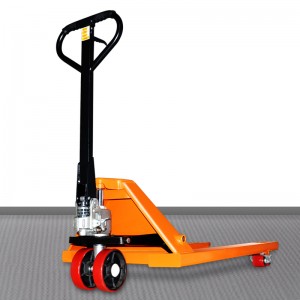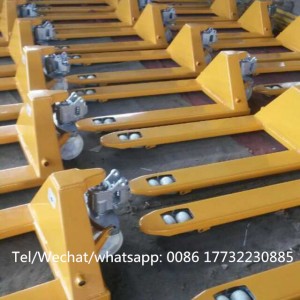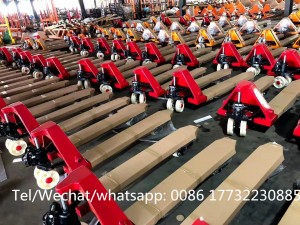A pallet jack, also known as a pallet truck or pump truck, is a manual or electric-powered tool used for moving palletized loads within a warehouse, distribution center, or other industrial settings. It is designed to lift and transport pallets without the need for heavy machinery or forklifts. Here’s some information about pallet jacks:
1, Design and Components: A pallet jack consists of a wheeled chassis, a pair of forks, a hydraulic pump, and a handle. The chassis is typically made of steel and features wheels or rollers, allowing for easy maneuverability. The forks are positioned under the pallet and can be raised or lowered using the hydraulic pump. The handle is used to control the lifting and steering of the pallet jack.
2, Manual Pallet Jacks: Manual pallet jacks are operated by hand. They require the operator to pump the hydraulic handle to raise the load off the ground. The operator can then push or pull the loaded pallet jack to transport the load. The hydraulic release lever is used to lower the forks when necessary. Manual pallet jacks are commonly used for lighter loads or in areas with limited space.
3, Electric Pallet Jacks: Electric pallet jacks, also known as powered pallet jacks or electric pallet trucks, are equipped with an electric motor that provides lifting and propulsion capabilities. They are typically operated using a control handle and require less physical effort from the operator. Electric pallet jacks are suitable for heavier loads and longer distances, offering improved efficiency and productivity.
4, Load Capacity: Pallet jacks come in various load capacity options, ranging from a few hundred kilograms to several tons. It is important to select a pallet jack with a load capacity that exceeds the weight of the loads you need to move.
5, Types of Pallet Jacks: In addition to the manual and electric classifications, pallet jacks come in various configurations to meet specific application requirements. Some common types include:
1) Standard Pallet Jacks: These are the most common type and are designed for standard pallet sizes.
2) Low-Profile Pallet Jacks: These pallet jacks have a lower fork height, allowing them to work with pallets that are closer to the ground or have a reduced clearance.
3) High-Lift Pallet Jacks: High-lift pallet jacks have an extended lifting height, enabling them to lift loads to higher levels, such as shelving or racks.
4) Rough Terrain Pallet Jacks: These pallet jacks feature larger wheels and a sturdier construction to handle uneven surfaces and outdoor environments.
6, Safety Considerations: When using a pallet jack, it’s important to observe proper safety precautions, such as:
1) Ensure proper training for operators on how to safely operate and maneuver the pallet jack.
2) Regularly inspect the pallet jack for any signs of damage or wear and perform necessary maintenance.
3) Use the pallet jack only within its specified load capacity.
4) Pay attention to the weight distribution and stability of the load to prevent tipping or accidents.
5) Be cautious of obstacles, uneven surfaces, and pedestrians in the work area.
6) Follow proper lifting techniques and avoid overexertion when using a manual pallet jack.
Pallet jacks provide a cost-effective and efficient solution for moving palletized loads in various industrial settings. They offer versatility, ease of use, and improved maneuverability compared to larger equipment like forklifts.
Post time: Aug-27-2023







